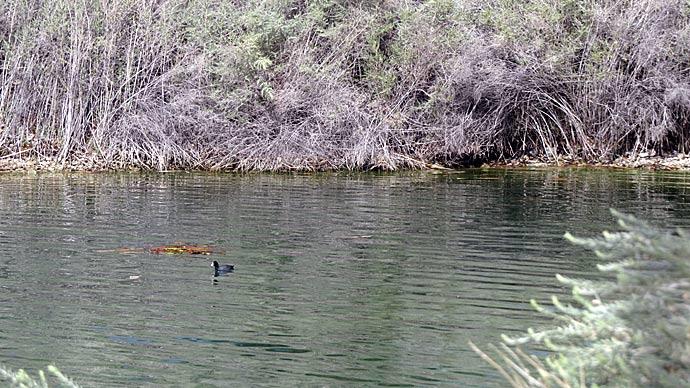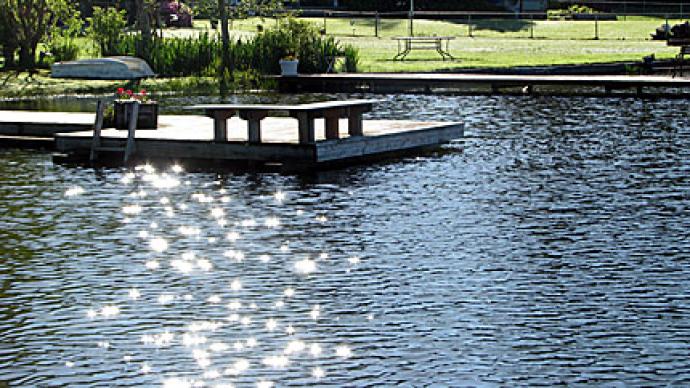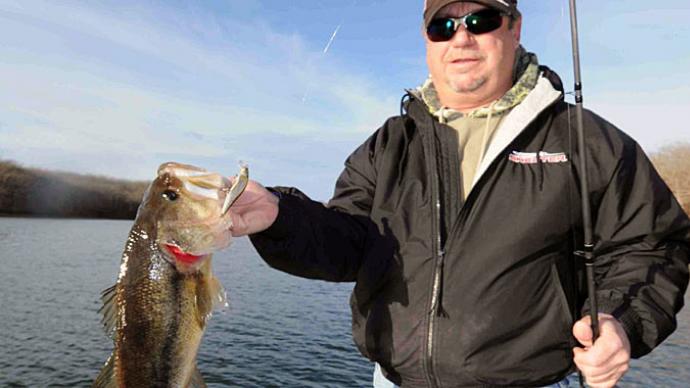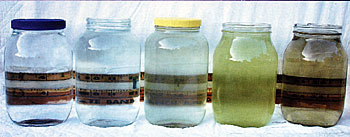
Your pond has a greenish tint to it, while your neighbor's fishing hole is strikingly clear. What's up with that? It has everything to do with "trophies." What in the heck is that word all about?
The word "trophic" means "relating to, or characterized by nutrient value." That word, "trophic," applies directly to your pond or lake. The process of lakes increasing in nutrient load is called "eutrophication."
Here you are, the proud parent of a brand new pond. The smell of freshly moved earth still lingers in your nostrils. Fresh water, from recent rains, filled your new baby enough to stock fish. Forage fish are stocked and all is well. Several months later, in go the bass or other predator fish.
The first year, your fish grow fast and water is clear. You can see your feet when you swim. You are almost giddy. Fish gorge themselves at your feeder(s).
Year two, things begin to change a bit. Several rains have washed some silt into the upper reaches. Plants are beginning to grow around the edges. Some gooey, mucky green algae pops up in the spring, but goes away by summer. All is still well.
You continue to feed your precious finned creatures and finally, you catch a bass on your favorite jig. It looks like a green-backed NFL football with bulging eyes, a big mouth and muscle-bound tail.
Year three, things change even more. Fishing is a blast, but that darned algae is a nuisance. It's enough of a problem to think about treating it. Last year's rooted plants are encroaching into some of your favorite fishing holes. The clearwater now has a green stained look to it.
Natural Aging
Your lake is doing what comes natural to every body of water like it. It is going through the natural process of eutrophication, where the water body accumulates nutrients. "Eutrophy" is derived from the German word (eutrophe) that generally defines "nutrient rich." The "trophic" terms were introduced in 1919 and were distinguished on basis of phytoplankton populations... in other words, the amount of productivity.
Differences in runoff and watershed determine the rate of lake aging. But, don't confuse lake aging directly with eutrophication. A lake "dies" when it is filled in with "soil"-mostly undecomposed organic deposits.
As goes the fertility, so goes eutrophication. So, the amount of food you feed your fish, how much fertilizer your neighbor puts on his crops, the amount of manure from passing waterfowl, or the way you manage shoreline vegetation and watershed influences eutrophication. Nature helps by providing a mass of tree leaves each fall, along with decaying underwater vegetation and algae. Much of what goes into a pond in the form of solids stays there. The water simply responds to those stimuli. If your pond is challenged to process loads of nutrients, expect lots of greenery. If your pond absorbs the watershed's runoff of loose or barren soils, expect siltation and nutrient enrichment. How long does it take? It depends on the rate of flow into the pond, how well your water processes natural wastes and nutrients and how fast downstream if your pond has a flow-through system.
The fundamental definition of eutrophication is the process of increasing the amount of nutrient input into a lake beyond its "natural" supply. It's often attributed to increased fertilization which leads to higher biological production. As all good aquaculturists know, fertile water grows lots of good fish. We like fertile water, at least as long as it's not TOO fertile.
But, as you will soon see, there are consequences. Some are great. Others, depending where you live, aren't quite so good. Still others, no matter where you live, aren't so good, either.
Trophic Categories
The "trophic" state of a lake generally refers to how much of an overall nutrient load it contains. Here are the terms.
"Oligotrophic" means very little nutrient content. Oligotrophic lakes, especially those in the private sector, are usually fairly sterile, low fish production, unusually clear water, very few aquatic plants and a rocky or sandy shoreline. Oxygen levels at all depths seem to stay near saturation all year long. Most cold water fisheries are considered oligotrophic. Most newly built private lakes tend to lean toward the oligotrophic stage, based on the amount of nutrient accumulation. That's why biologists recommend fertilizing warmwater fisheries. Their water is too clear and infertile to produce the lush food chain for growing lots of warmwater fish.
"Eutrophic" is the other end of the nutrient spectrum. Eutrophic ponds and lakes are typically older, have high levels of nutrients, full of aquatic plants and shallow. Keep in mind, though, that while eutrophication and aging tend to go hand in hand, they are not the same. They are usually on a parallel course. Some ponds have actually aged themselves to the brink of extinction without becoming eutrophic.
Here's what we mean.
Across the South and parts of the Midwest, the United States government built thousands of flood control lakes, starting in the late 1950's through the mid 70's. The mission was to slow down flood waters by retaining them behind huge dams on private property, then releasing that water slowly enough for rivers to manage excess water so people downstream weren't flooded.
The Soil Conservation Service called these lakes "flood prevention" lakes early on, and then renamed them "floodwater retarding structures" later. Most of these lakes were designed and planned for sediment storage as well as floodwater storage. The sediment pools were designed, on paper at least, to fill with sediment in 50 years; thus they were said to have a 50-year lifespan. The sediment pools still hold lots of water in these older lakes. As designed, all they should hold after that time-span should be flood waters.
The SCS may have over-designed, which wouldn't be the first time. Land use in drainage areas changed from cropland to pasture, woods or other land uses that actually yielded less sediment than cropland, which SCS probably used in its original design calculations. Even where cropland has been the continued use over time, improved farming practices-parallel terraces, grassed waterways, reduced tillage, improved implement-have resulted less sediment yield into these lakes.
Fast forward 35-40 years.
Most of those lakes are at least 50% silted in. But, water is cleaner, clearer and not nearly as nutrient enriched as we might think. Fast flowing flood water came in, was retained and slowly released. As water was released during these high water events, the sediments carried in with fast moving water are able to substantially settle ... in the bottom of these lakes. Over time, with 25 to 30 flood events, each lake receives, and keeps, tons of sediment.
That's aging.
On the other hand, look at other types of lakes and ponds. Remember George Perry's world record largemouth bass, caught in 1932? He caught the 22 pound 4 ounce monster in Montgomery Lake, an oxbow off the Ocmulgee River near Jacksonville, Georgia. Now, that lake is no longer a lake. It's more like a swamp, shrunk by years of eutrophication, mixed with normal aging. More than once, someone calls the Pond Boss office, wishing to renovate a pond ... the one where they caught fish as a child. These good people wish to reverse the effects of time ... and eutrophication.
Trophic Conditions
A eutrophic lake or pond typically has a soft, mucky bottom.
An oligotrophic lake has a firm, solid, rocky or sandy bottom.
Like Ron Popeil might say on one of his commercials, "Ah, but there's more!" Mesotrophic is the intermediate trophic state. It's not new, but not "old," either. It's in the middle, kind of like a teenager. Strong back, no wrinkles, but kicked around just enough to watch closely. Mesotrophic lakes have moderate nutrient loads, light plankton blooms and some sediment over much of the lake bottom. This is a "typical" warmwater fishery.
Now, for the fun part.
Oligotrophic waters have dissolved oxygen at all levels, all summer long, even below the thermocline. These are the lakes which can support warmwater fisheries in the top layer all summer, and keep cold water fish alive below the thermocline in the oxygenated cold water. Top water may reach the 80's in summer, but drop down 15 or more feet and find oxygen enriched water with temperatures in the 50's or 60's. Visibility in oligotrophic lakes often extends well beyond 12 feet.
Mesotrophic lakes have dissolved oxygen in the hypolimnion (middle layers) most of the summer. These lakes area a little tricky when trying to support cold water fish such as trout. Sometimes they thrive, sometimes they don't.
Eutrophic lakes don't have useful dissolved oxygen below the thermocline in the middle of summer. No living creature with gills dares stay very long in deep water in a eutrophic lake ... except maybe a gar or a bowfin ... not the fish we would choose to thrive.
As you can see, this "trophic" stuff is a progression, based on the nutrient value of water. Fisheries management is often dependant on our ability to control nutrient levels of water.
The next "trophic" is hypereutrophic. These waters are characterized by over-fertile waters, typical of older ponds. Hypereutrophic waters typically have heavy bluegreen or planktonic algae blooms and are susceptible to duckweed and/or watermeal. Don't be surprised to see hypereutrophic ponds with thick green film or scum on top ... at least part of the year.
We have one last "trophic" to tell you.
Dystrophic is a limnology term used to describe waters often having a low pH, lack of nutrients and a high humus content. Plankton and fish are typically sparse, shallow water vegetation abundant and water has a high oxygen demand. This water looks "tea-stained." This stage sometimes follows the hypereutrophic phase in the life cycle of a lake. Or, the soil types of a region can be the cause of dystrophic waters. These waters are usually called "brown" or "black" water lakes.
For all you technical biology thinkers, we need to include some specific limnology terms. Technically, "trophy" refers to the rate of supply of organic matter, while "dystrophy" denotes a high loading or input of "outside" (allochthonous) organic matter. Usually, littoral plants dominate the productivity of dystrophic lakes-many of them are bog or even swamp-type lakes, like Montgomery Lake.
So, there you have it. All those "trophies" that biologists speak of. The grouping of water bodies into trophic categories is a spectrum of states of lake metabolism between oligotrophy and eutrophy. Almost every lake or pond falls somewhere on the spectrum continuum from oligotrophy to hypereutrophic or dystrophic. It makes sense for you to study your pond and understand its status through the course of several seasons. This understanding helps you realize why the trout did not survive in your pond despite of really deep water. It also helps you understand why you see the thousands and thousands of bluegill that make your bass grow like a sumo wrestler. The more you understand how this stuff works, the better manager of the water you inevitably become.
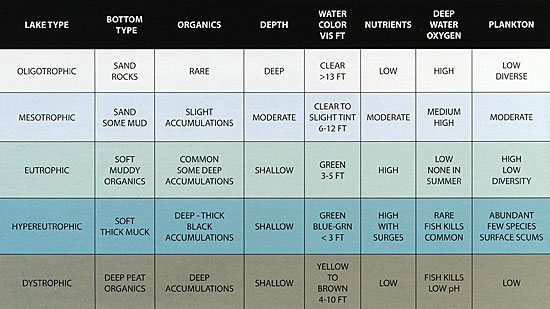
Table 1. Basic features of lakes with different trophic conditions.

Table 2. Predominant fishery features of various trophic lakes.
Acknowledgements
The authors thank Dr Dave Willis, a professor in the Department of Wildlife and Fisheries at South Dakota University for providing some information for standing crops of fish that are characteristic of the various trophic categories.
Reprinted with permission from Pond Boss Magazine

